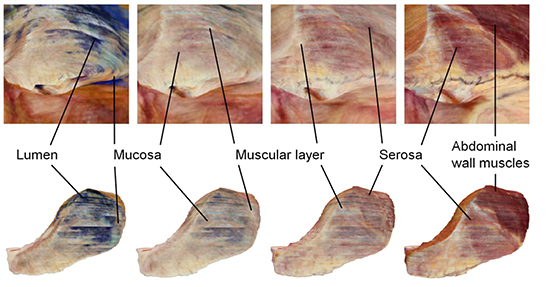1. Shin DS, Chung MS, Shin BS, Kwon K. Laparoscopic and endoscopic exploration of the ascending colon wall based on a cadaver sectioned images. Anat Sci Int. 2014; 89:21–27.
2. Park JS, Chung MS, Hwang SB, Lee YS, Har DH, Park HS. Visible Korean human: improved serially sectioned images of the entire body. IEEE Trans Med Imaging. 2005; 24:352–360.
3. Borgefors G. On digital distance transforms in three dimensions. Comput Vis Image Und. 1996; 64:368–376.
4. Pudney C. Distance-ordered homotopic thinning: a skeletonization algorithm for 3D digital images. Comput Vis Image Und. 1998; 72:404–413.
5. Park JS, Chung MS, Hwang SB, Lee YS, Har DH. Technical report on semiautomatic segmentation using the Adobe Photoshop. J Digit Imaging. 2005; 18:333–343.
6. Shin DS, Park JS, Lee SB, Lee SH, Chung J, Chung MS. Surface model of the gastrointestinal tract constructed from the Visible Korean. Clin Anat. 2009; 22:601–609.
7. Shin DS, Park JS, Park HS, Hwang SB, Chung MS. Outlining of the detailed structures in sectioned images from Visible Korean. Surg Radiol Anat. 2012; 34:235–247.
8. Mescher AL, Junqueira LCU. Junqueira's basic histology : text and atlas. 13th ed. New York: McGraw-Hill;2013. p. 303.
9. Krüger J, Westermann R. Acceleration techniques for GPU-based volume rendering. In : Proceedings of the IEEE Visualization, 2003; Seattle, Washington. IEEE;2003. p. 287–292.
10. Hadwiger M, Kniss JM, Rezk-salama C, Weiskopf D, Engel K. Real-time volume graphics. A. K. Peters, Ltd.;2006. p. 163–185.
11. Park JS, Chung MS, Hwang SB, Shin BS, Park HS. Visible Korean Human: its techniques and applications. Clin Anat. 2006; 19:216–224.
12. Park JS, Jung YW, Lee JW, Shin DS, Chung MS, Riemer M, Handels H. Generating useful images for medical applications from the Visible Korean Human. Comput Methods Programs Biomed. 2008; 92:257–266.
13. Shin DS, Chung MS, Park JS, Park HS, Lee S, Moon YL, Jang HG. Portable document format file showing the surface models of cadaver whole body. J Korean Med Sci. 2012; 27:849–856.
14. Ackerman MJ. The Visible Human Project: a resource for education. Acad Med. 1999; 74:667–670.
15. Jastrow H, Vollrath L. Teaching and learning gross anatomy using modern electronic media based on the Visible Human Project. Clin Anat. 2003; 16:44–54.
16. Heng PA, Zhang SX, Xie YM, Wong TT, Chui YP, Cheng CY. Photorealistic virtual anatomy based on Chinese Visible Human data. Clin Anat. 2006; 19:232–239.
17. Liu K, Fang B, Wu Y, Li Y, Jin J, Tan L, Zhang S. Anatomical education and surgical simulation based on the Chinese Visible Human: a three-dimensional virtual model of the larynx region. Anat Sci Int. 2013; 88:254–258.
18. Shin DS, Chung MS, Park HS, Park JS, Hwang SB. Browsing software of the Visible Korean data used for teaching sectional anatomy. Anat Sci Educ. 2011; 4:327–332.
19. Shin DS, Chung MS, Lee JW, Park JS, Chung J, Lee SB, Lee SH. Advanced surface reconstruction technique to build detailed surface models of the liver and neighboring structures from the Visible Korean Human. J Korean Med Sci. 2009; 24:375–383.
20. Park JS, Chung MS, Chi JG, Park HS, Shin DS. Segmentation of cerebral gyri in the sectioned images by referring to volume model. J Korean Med Sci. 2010; 25:1710–1715.




 PDF
PDF ePub
ePub Citation
Citation Print
Print






 XML Download
XML Download